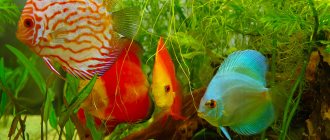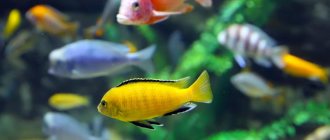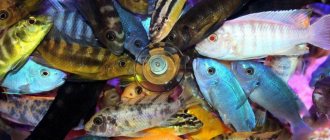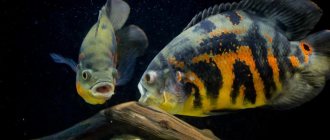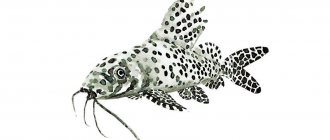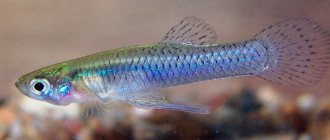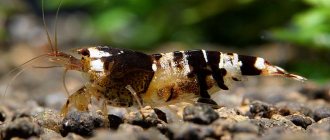Cichlids are beautiful fish with bright colors and unusual shapes. They recognize their owner and are extremely sensitive to their own offspring. We will tell you about all the features of their behavior, maintenance and reproduction.
| Full name | Cichlids/Cichlidae |
| Kinds | acara, apistogramma, ramizer, cichlazomy, angelfish, discus, melanochromus, chromis, mbuna, etroplus, oscar, parrot, tropheus, pseudotropheus, lamprologus |
| Color | Black, white, yellow, red, blue, blue, green, striped, spotted |
| Water | Volume per fish – from 50 liters PH (acid-base balance) – 6-8 pH KH (hardness) – 5-15° dH t (temperature) – 20-28 °C |
| Feed | Live food - bloodworms, tubifex, coretra, daphnia, gammarus and brine shrimp; frozen food of the same types; feeding from boiled and crushed eggs, meat, liver, sea fish; vegetable food - tablets and flakes with spirulina algae, blanched vegetables, dried herbs; dry food, balanced in terms of vitamins, minerals and fiber – Tetra Malawi, Tetra Cichlid Mini Granules, Tetra Cichlid Color, Tetra Cichlid Sticks |
| Compatibility | preferably kept with other cichlids of comparable size |
| Priming | Coarse river sand |
| Plants | anubias, floating plants |
| Scenery | Shelters – driftwood, weathered rocks, grottoes or caves |
| Lifespan | They live up to 10-15 years in an aquarium |
Description
Cichlids from Africa are majestic beauties whose special character and behavior have long captivated lovers. They have not only individuality, but also some intelligence: they are able to recognize the owner and, to some extent, become attached to him.
It is believed that the ancestors of African cichlids were marine fish - which is why among them you can find species that prefer brackish water. Today, this large group of fish occupies a significant part of Africa, living mainly in its eastern part. Their greatest diversity can be found in the Great Lakes of Malawi and Tanganyika, and some of the species have been caught as commercial fish for many years.
Lake Malawi is particularly densely populated by cichlids: about 800 species are already known, of which only 300 have been described. The water there is clear and clean, and the acidity is always stable. That is why aquarium species native to Malawi are demanding of these parameters.
The next most populated lake, Lake Tanganyika, is considered the second deepest in the world, and spreads over a huge area: more than 32 thousand square meters. km. For this it was even nicknamed “lake-sea”. The oxygenated waters of Taganyik are home to 250 species of cichlids, as well as 150 other species of fish. It can also boast that it was there that the smallest and largest cichlid fish in the world were found.
The largest recorded individual is a representative of the species Boulangerochrome small-scaled, growing up to 90 cm. The smallest is Nanochromis transvestitis, which barely reaches 2.5 cm in length.
African cichlids can also be found in other lakes: Victoria, Kivu, Eduard, Rudolf, Albert, George, Nabugabo. But they inhabit not only standing water; some of the species are content with flowing water and live, for example, in the Congo River basin.
Cichlids from Africa are a very large group of fish, including representatives of very different appearances: most often the fish have an elongated body and a striking color. Most of them are carnivores, but there are also vegetarians. Depending on the species, African fish live in an aquarium from 5 to 18 years, and in natural conditions some species live up to 25.
Parrot (Cichlasoma sp.)
The parrot is perhaps the most commonly found cichlid in home aquariums! This is a selectively bred fish, the ancestors of which live in the waters of America. Parrots are unpretentious and attractive! Their body is tall, barrel-shaped, with expressive eyes and a rather large mouth bordered by thick lips on the head. The coloring of parrots is varied: they can be plain (red, yellow, green and others), or they can have artificial patterns on the body (tattoos of various shapes and colors). Parrots grow up to 25 cm and can live about 10 years. These fish need spacious aquariums of 150-200 liters. Parrots can lay eggs, but they almost never produce offspring.
Conditions in the aquarium
Most African cichlids can be kept in a glass aquarium. They feed on algae, live food, and plant foods. You can create a semblance of a natural biotope by installing the semblance of rocks or rock caves in the reservoir. You should be careful when choosing soil - fish can dig it up or eat it if a piece of stone fits in their mouth. Plants are dug up, so plant potted hard-leaved species.
African cichlids require a lot of space to swim; install a large water tank with a capacity of 100-250 liters for a couple of fish. It is necessary to ensure good aeration and filtration of water, constant renewal of 30% with fresh water. Sometimes gravel and filter plates are moved, deteriorating the quality of the latter. The temperature in the aquarium should be maintained at 24-27o C.
It is important to monitor the acidity and alkalinity levels of the water. In all lakes in Africa, the water is different, so keeping each species requires special living conditions. Malawi has a pH of 7.7 to 8.7, Lake Tanganyika can have a pH of 9.3. The average range for African cichlids is pH 8.5, although they can survive in a neutral pH of 7.0, or even an acidic pH of 6.0. But low pH levels make fish susceptible to diseases, loss of color, and they stop reproducing.
Almost all species of cichlids from Africa are predators: they eat insect larvae, worms and fish. They can be fed live foods, frozen and cooked foods, seaweed, flakes and kibble. Some species are supplemented with carotene so that the scales are saturated with pigment. Herbivorous cichlids prefer plant foods rich in fiber: spirulina, salads, cereals, moss, duckweed.
Pelvicachromis kribensis (Pelvicachromis pulcher)
Pelvicachromis kribensis is a small, bright, relatively peaceful, unpretentious cichlid native to the waters of Africa. Pelvicachromis are often found in community aquariums with small, calm fish. The suitable volume for them is from 50 liters. Pelvicachromis has an elongated body, slightly flattened laterally. The color of the fish attracts attention: on a gray background there is a dark horizontal stripe separating the light back and crimson belly. The dorsal and caudal fins have a bright eye-shaped pattern. Cribensis grow up to 8-10 cm and live for about 3-4 years.
These small fish easily reproduce in home aquariums, carefully caring for their offspring.
Kinds
There are a lot of species of these African fish, and just as many among them are those who have been living in amateur aquariums for a long time. Conventionally, they can be divided according to their habitat. Some of the species are endemic, that is, they are found only in the territory of one body of water.
Thus, the colorful Malawian inhabitants are divided into two types: mbuna and utaki. Representatives of the first group are herbivores and live on rocky areas of the bottom with dense vegetation. This greatly determines their behavior in the aquarium: they love to search the bottom in search of food, often uprooting plants in the process.
The group of Malaiwi mbuna includes such popular species as:
- pseudotropheus;
- labidochromis;
- tropheus;
- tropheops;
- melanochromis;
- cinotilapia.
The utaka group consists of fish that inhabit the coastal part of the lake, as well as underwater reefs. There they feed mainly on animal food, not disdaining their relatives. They are much larger than the Mbuna representatives, they can reach 25 cm and therefore they require more space.
In aquariums you can find such Malawian utakas as:
- buccochromis;
- aulonakara;
- lethrinops;
- protomelas.
In the waters of Malawi, there are other species of cichlid fish, larger ones and all of them are predators. But due to their large size, as well as strong aggressiveness, they are almost never found in aquariums.
Cichlids from Lake Tanganyika inhabit its different zones: the surf zone, muddy, rocky, sandy bottom, as well as the deepest layer. From this giant lake the following species came into the aquarium hobby:
- cyathopharynx, or blue princess;
- shell lamprologus;
- bull cichlids;
- various trophies.
Among the aquarium inhabitants you can also meet guests from another large African lake - Victoria. They get along well with the neighbors of Lake Malawi, but are not ready to coexist with the fish of Tanganyika. In addition, they grow faster than those listed and therefore quickly occupy a leading position.
Most often in aquariums you can find such Victorian cichlids as:
- Brown's haplochromis;
- black nanochromis.
Due to their small size, dwarf cichlid species that came from the lakes of West Africa are becoming very popular. More often peaceful, but just as colorful as their larger relatives, they have captured the hearts of aquarists.
The following dwarf African cichlids are especially popular:
- kribensis;
- various pelvicachromis;
- nanochromis.
Haplochromis cornflower (Xiphophorus hellerii var.)
Haplochromis cornflower, or cornflower, as aquarists affectionately call it, is a bright, showy fish native to Lake Malawi. Haplochromis has a swift, elongated body with a narrow head. The color of the males is incredible: neon blue. Females and juveniles are much more modestly colored; they are gray, sometimes with stripes. Fish grow up to 20 cm and live 5-6 years.
Cornflowers are territorial; it is better to keep them in a harem or alone. The volume is suitable for them from 150-200 liters. Haplochromis always attracts the eye and serves as a decoration for the aquarium!
Cornflower haplochromis reproduce like other cichlids from Malawi: females carry eggs in their mouths.
Feeding
Almost all cichlids in nature are predators, and therefore the basis of their diet should consist of protein. In an aquarium, they can be given dry, frozen and live food. Some species are specially added with carotene to make their color brighter. Herbivorous species prefer foods high in fiber: they can be given special industrial diets, as well as lettuce, spirulina and duckweed.
When populating an aquarium, it is important to take into account the nutritional needs of the fish and not plant vegetarian and meat-eating fish together. Otherwise, carnivores will starve forever, while herbivores risk suffering from poisoning from the remains of protein feed. Channel member Elena Fankenthal will share her experience in selecting food. Watch the video below to learn some secrets about the diet of Lake Malawi cichlid fish.
Turquoise acara (Aequidens rivulatus)
Turquoise acara is a spectacular, powerful fish. Found naturally in American waters. Akara has a strong body with a pointed head. In males, by the time they reach sexual maturity, a fat “cushion” appears in the forehead area. The fish are elegantly colored: neon sparkles are scattered on the gray body and fins, the dorsal and caudal fins are bordered by a bright red stripe. Males grow larger than females, their size is about 20 cm, and they live for about 10 years. These fish need spacious aquariums of 150-200 liters.
Acaras easily reproduce in home aquariums, taking responsible care of the fry.
Cichlid breeding
This process is quite interesting. Usually, for spawning, a place is prepared in the aquarium, in the form of a small hole or shelter in a snag. The spawning itself does not last long. The female lays eggs, which are sprayed with milk by the male. The female immediately picks up the eggs in her mouth along with the milk, thus fertilizing them. The female carries the eggs in her mouth in a special recess, and practically does not feed during this period. The larvae develop in the eggs due to the reserves in the eggs. When the fry hatch, they still live in the mother's mouth. Only sometimes does she release them “into the wild” to feast on zooplankton and eat herself. In case of alarm, the fry immediately hide in their mother’s mouth. To make the process of raising fry easier, it is better to place the female in a separate aquarium, where there will be no other fish and there will be no danger to the fry.
Angelfish (Pterophyllum scalare)
The angelfish is a popular and recognizable fish among aquarists, native to the waters of America. Angelfish have a highly flattened, high triangular body with long, showy fins, the pectoral fins of which have thinned and taken on the appearance of graceful threads. The color of the fish is varied: silver, gold, black, tricolor, striped or spotted. Angelfish grow about 15-20 cm and live for about 5 years.
An aquarium of 80 liters or more is suitable for these fish. Angelfish are quite unpretentious and relatively peaceful, suitable for a community aquarium with active, friendly neighbors. These fish are spawning fish and their reproduction in an aquarium is not difficult.
Compatibility of African cichlids with other aquarium fish and inhabitants
And finally, about the compatibility of cichlids, or rather their incompatibility. Cichlids are limitedly compatible with barbs, eels, labeos, axtronotuses, and loaches. They don't get along with other fish. Although it is possible to create certain conditions when cichlids are not aggressive, and then it is possible to keep them with other fish. But this comes with experience.
MALAWIAN CICHLIDS: VIDEO, DESCRIPTION, PHOTO, CARE, BREEDING
AMERICAN CICHLIDS CARE DESCRIPTION REPRODUCTION SPECIES COMPATIBILITY
Discus (Symphysodon aequifasciatus)
Discus is a royal cichlid! So named for its grace, stature and incredible beauty. However, their demandingness and capriciousness does not allow beginners to keep discus, although, of course, this is the favorite fish of many.
The homeland of discus fish is the Amazon River, America. Today, a large number of color variations of these fish have been bred. Discus fish have a flat, tall body. The color of these fish is varied: blue, red, white, yellow, dark blue, plain, spotted, striped, etc. They grow about 20 cm and live 5-7 years.
You can't take your eyes off the discus aquarium! A special feature of keeping these fish is the high water temperature (+28..+30 degrees), so they should be kept in a species aquarium. For discus, a volume of 200 liters or more is suitable.
Discus spawners. They are caring parents, feeding their offspring at first with mucus from their bodies, the so-called “milk”.
Zoning
To create “privacy” for the inhabitants of the cichlid, to delimit their territories and avoid conflicts, you need to properly divide the landscape into separate areas using screens of plants and decorative elements.
You should observe where each couple prefers to relax, in which sector of the aquarium they most often dig, and place there half a coconut shell, a fragment of a ceramic pot or a grotto under the cover of a bush of vegetation.
Zoning will have to be improved frequently until the cichlids are satisfied with the division of the territory. Their reaction will be noticeable in their behavior and relationships with neighbors.
General requirements
To take all factors into account as much as possible, aquarists create a geographical cichlid fish tank, in which they select plants and fish from a certain region. The biotope cichlid also looks interesting, in which the characteristic features of the habitat - a lake, a stream - are reproduced with great accuracy. There are general requirements for making a mixed aquarium for different types of cichlids.
Aquarium for cichlids
First of all, you need to select and arrange the aquarium.
Size
The average size of cichlids is about 30 cm, so the volume should be large. It is recommended to proceed on the basis of 1 cm of fish body per 2-3 liters of water.
For 1 cichlid you need at least 50-60 liters.
Cichlids are schooling fish, so this also needs to be taken into account. It is equally important to consider the territorial behavior of cichlids.
In order for the fish not to show their aggressive, quarrelsome nature, they must have enough space for their own space, which other fish will not constantly invade, especially during the breeding season. Taking into account all factors, it is recommended to choose a capacity of at least 120-200 liters.
Form
A significant volume of water requires high strength glass and reliable seams.
Preference should be given to a rectangular aquarium of the “trough” type – with a length of 90-200 cm.
This way the fish will have more free space to swim and have the opportunity to zone the space.
Excessive forms are not welcome - additional corners and protrusions will distort the view, interfere with visibility, and create “dead” zones for free circulation of water. In such “pockets” it is difficult to clean the soil from biological residues, which over time will begin to decompose, releasing toxic substances.
Filtration
Cichlids leave behind a large amount of waste; they love to rummage in the soil, raising turbidity, and tearing off leaves from plants. All this requires a good cleaning. Therefore, filters in cichlids must be powerful with high productivity and several degrees of purification - mechanical, chemical, biological.
Pump and water heater
To circulate water, mix layers and saturate with oxygen, there must be a powerful pump that provides good aeration. To recreate the microclimate of the tropics and subtropics, you need a water heater with temperature control. During the winter months, it will prevent the temperature from dropping too much, leading to the death of the cichlids.
Location and anchoring
To place the cichlid, you should choose a place away from a source of natural light. These types of fish do not like bright sunlight, preferring shade. Away from windows in the aquarium there will be less risk of algae growth.
Last but not least, a strong support is important in the structure of a cichlid. A large-volume aquarium weighs a lot and this requires proper placement, a reliable base, and even distribution of the load.
Cichlid bottom
The requirements for the soil with which the bottom of the cichlid is covered are determined by:
- cichlids love to dig up the soil, therefore, it should be such that the fish do not get hurt and there is no agitation;
- creating a winning background - the color of the soil should emphasize the beauty of the color and shape of cichlids;
- simplicity and ease of cleaning.
As a soil you can choose:
- Snow-white, cream or gray marble chips with a diameter of 1.5-2 mm. The advantage of such bottom covering is safety, absence of turbidity, and creation of a snow-white background for decor and fish. In addition, marble chips slightly increase the water hardness, which is important for cichlids.
- Coarse quartz sand.
- Small rounded pebbles.
- Black basalt with a fraction of 3-6 mm.
- Screening of granite with a fraction of 2-6 mm.
- Crushed stone screening, fraction 2-6.
It is enough to fill such soil with a layer of 5 cm. The larger the soil, the thicker the layer can be. It will be convenient to bury pots with plants in it. When choosing a soil fraction, it should be taken into account that some types of cichlids like to roll pebbles in their mouths - too large particles can damage the oral cavity. So aquarists choose the soil in accordance with the size of the fish and the type of planned landscape.
Decoration
Cichlids need grottoes, rock slides and driftwood. They are not only decorative elements that allow you to create a beautiful landscape. Fish love to hide and rest in grottoes. Some species of cichlids attach eggs to the roof or walls of grottoes.
With the help of stone slides, you can zone the space, dividing the territories of individual pairs of fish. But when creating a landscape, you must adhere to safety considerations:
- Large stones must be secured so that the fish do not overturn them to the bottom or crush each other. Silicone is used as a “backing” to make the slide stable and not break the glass.
- The entrance to the grotto should be quite spacious so that the fish do not get stuck.
- The edges of the decorative elements should not be sharp so that the cichlids do not get hurt.
You need to decorate the bottom of the aquarium so that there is free space for swimming - do not get too carried away with decoration. All elements must be harmoniously combined.
The driftwood used in the design of the cichlid fish will not only naturally fit into the landscape of the underwater world, but will also improve the characteristics of the water - make it softer and saturate it with natural tannins, which have antibacterial properties. You will have to constantly “rework” the decorations, since cichlids can move, drop and bury some elements.
Plants for cichlids
Most cichlid aquarists eschew vegetation in favor of artificial plants or rocky moonscapes. But you shouldn’t give up an additional biological filter and oxygen source.
Selection rules . When choosing plants for your cichlid garden, you should give preference to unpretentious, fast-growing crops with rigid stems and dense leaves. Such plants should not require a nutrient substrate, recover quickly and comply with the characteristics of the water. To insure the root system from damage, plants can be planted in pots that are secured in the ground with weights.
Which ones are suitable?
The optimal choice for a cichlid is:
- hygrophila;
- nymphs;
- gymnocoronis;
- monosolenium;
- Vallisneria;
- cryptocorynes;
- Brazilian pinnate;
- Echinodorus;
- limnophila ambulia;
- aponogeton ulvoides;
- ferns.
Floating vegetation is not of interest to cichlids, so various types of duckweed, riccia, cladophora, and pistia will create the diffused light so beloved by cichlids and decorate the aquarium.
Planting rules. Tall plants are planted along the walls of the aquarium, plants in the middle ground are arranged in separate picturesque groups. Fluffy green mosses are used to decorate driftwood and stones. Many aquarists note that if plants are not located on the “paths” of cichlids, then they are not interested in them. Experience and observation of the habits of cichlids will help you position the plants correctly.
Reviews
The Malawian cichlid is a very beautiful and intelligent fish, but quite aggressive. We got two motley mbunas, but one beat the other to death and now she has been living alone for over a year. But it’s very interesting to watch her alone, how she jumps up when you approach the aquarium, dragging pebbles and melaniums)) Arina, 21 years old
I bought cichlids because I had liked them for a long time, but I had no idea that keeping them would be so difficult. First, they ate all the guppies in the common aquarium, and they had to be urgently removed. Later, another fact was discovered - they grow very quickly, so when they became cramped in a small aquarium, they returned to the pet store. For myself, I concluded: these fish are for large rooms and I don’t want to deal with them anymore! Evgeniy, 36, Ekaterinburg
At the pet store, I couldn’t take my eyes off the cichlids and bought myself pets of different shapes and colors. At first I fed them expensive food, but gradually switched to cheaper brands, and this did not affect their color or their health. In addition, they reproduce quite well, even too well for me! Lyudmila, 60 years old, Omsk
Diseases
If the appearance of the fish is alarming, and its behavior has changed, this may be due to one of the diseases that cichlids are susceptible to.
Fish diseases are most often caused by the following factors:
- injuries received during fights with neighbors in the aquarium or careless transportation;
- birth defects and anomalies;
- parasites and bacterial infections.
Diseases caused by poor diet or poor water parameters include Malawi disease, bug eye, and fin rot.
Various types of parasites are caused by ichthyophthyriosis, argulosis, hexamitosis, lernea, oodiniosis, and intestinal parasites.
A sick fish should be quarantined in a small separate aquarium, parasites removed, wounds treated with an antiseptic and kept separately using antibiotics. It is better to restart the general aquarium with complete cleaning of the soil, decor, and equipment.
Benefits of claria fish
The value of soma claria lies in its beneficial effects on all systems of the body. When consumed in moderation, fish:
- normalizes the functioning of the nervous system and helps cope with stress;
- improves cellular metabolism;
- strengthens blood vessels and prevents the development of atherosclerosis;
- protects the heart from illnesses;
- Helps maintain tone and energy;
- increases immunity and resistance to viral diseases;
- strengthens bones and joints due to the high calcium content;
- has a beneficial effect on mental and physical activity;
- improves the condition of hair and nails.
We recommend reading: Nelma: beneficial properties of fish, taste, calorie content
Claria fish can be consumed to prevent cancer and strokes. African catfish fillet prevents the development of osteoporosis.
Clarium fish normalizes blood sugar levels in diabetes
Handsome chromis (Hemichromis bimaculatus)
The beautiful Chromis is an “old” fish, but still popular among aquarists, originally from Africa. Chromis is unpretentious, great for beginners. The “handsome one” received its name for its incredibly bright red color with neon sparkles, which is especially pronounced during the spawning period. Chromis grow up to 15 cm and live for about 5 years.
These are quite aggressive and territorial fish, the suitable volume for them is from 80 liters.
Chromis spawn without any problems in a common aquarium, and at the same time they become even more aggressive towards their neighbors.
How to cook better
Clarium fish is widely used in cooking. It is combined with fresh and stewed vegetables, herbs and sauces, baked and fried, steamed and boiled. Simple recipes allow you to cook catfish quickly and without unnecessary complications.
Clarium fish in the oven
When baked in the oven, clariy retains maximum beneficial properties, remains low in calories and at the same time acquires special juiciness and tenderness. The ingredients needed for the recipe are:
- African catfish - 1 pc.;
- vegetable oil - 50 ml;
- lemon - 1 pc.;
- sea salt - to taste;
- rosemary - to taste;
- pepper - 1/2 tsp;
- paprika - to taste.
The step-by-step scheme for preparing fish looks like this:
- Claria is cleaned and gutted, and then washed and shallow cuts are made in the carcass along the entire length.
- Squeeze the juice out of the lemon and grate the fish.
- Claria is treated with salt, pepper, paprika and rosemary.
- Rub the spices thoroughly into the catfish carcass and leave it to soak for about half an hour.
- Preheat the oven to 180 °C, cover a wide baking sheet with foil and coat it with vegetable oil.
- Place the pickled catfish on a tray and bake for 45 minutes.
After the time has passed, the hot fish is served to the table, garnishing the claria with lemon slices and rosemary.
Attention! Cooking catfish is very convenient, since it has no scales, and the carcass does not have to be cleaned for a long time.
Baked African catfish fillet is particularly tender and contains almost no small bones
Fried clari fish in a frying pan
You can quickly cook catfish in a frying pan. When properly fried, the fish meat retains its juiciness, but acquires a pleasantly crispy crust. Ingredients you will need:
- Clarius fish - 1 pc.;
- sour cream - 1 tbsp. l.;
- lemon - 1 pc.;
- mayonnaise - 2 tbsp. l.;
- egg - 1 pc.;
- salt - to taste;
- flour - 3 tbsp. l.;
- vegetable oil - 50 ml;
- dill - 1 bunch.
The preparation scheme for African catfish is as follows:
- Claria fish is skinned, gutted and washed.
- Squeeze the juice from half a lemon, dilute it with water and soak the catfish for a few minutes to eliminate the characteristic river smell.
- Mix sour cream with mayonnaise and egg, beat thoroughly and add salt to taste.
- Add sifted flour to the dressing and mix until a homogeneous viscous batter is obtained.
- Wash the catfish again and cut the fillets into oblong pieces.
- Rub the fish meat with salt, and then dip each piece in the batter.
- Place the catfish on a heated and generously greased frying pan.
- Fry until golden brown on both sides.
Recommended reading: What are the benefits of catfish?
The finished fish is served with fresh herbs and your favorite sauce. Juicy and nutritious catfish retains a low calorie content, so it can be consumed in small portions without worrying about your figure.
When frying claria fish, it is important not to overcook it in a frying pan, otherwise the fillet will lose most of its benefits.
Clary fish cutlets
Light fish cutlets are a good dietary dish. To prepare them you need the following ingredients:
- African catfish - 1 pc.;
- white bread - 3 pieces;
- onions - 1 pc.;
- garlic - 3 cloves;
- vegetable oil - 3 tbsp. l.;
- egg - 1 pc.;
- butter - 50 g;
- flour - 4 tbsp. l.;
- salt - to taste;
- pepper - to taste.
The cooking process looks like this:
- Claria fish is cleaned, washed and filleted from the spine, and then minced in a meat grinder.
- Soaked bread, egg and spices are added to the resulting minced meat, after which the ingredients are thoroughly mixed by hand.
- Form cutlets, roll them in flour and place them in a heated frying pan.
- Fry for 7-10 minutes on each side.
Fish cutlets can be eaten with fresh vegetables, herbs and low-fat sour cream.
To make the clarium cutlets dense enough, if necessary, add a second egg to the minced meat
